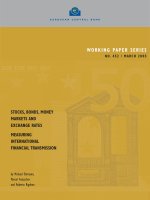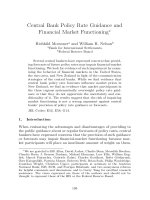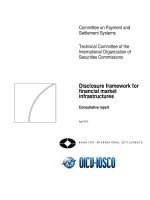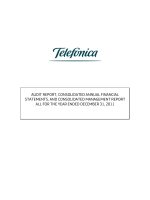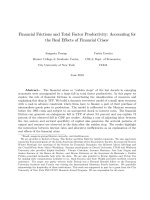International Financial Market and Korean Economy ISLM framework for an open economy
Bạn đang xem bản rút gọn của tài liệu. Xem và tải ngay bản đầy đủ của tài liệu tại đây (542.32 KB, 68 trang )
International Financial market and Korean Economy
Prepared by Seok-Kyun HUR
IS-LM Framework for an Open Economy
Based on Blanchard’s Chapter18~20
Openness in Goods and Financial Markets
1.
2.
3.
Openness has three distinct dimensions:
Openness in goods markets. Free trade restrictions
include tariffs and quotas.
Openness in financial markets. Capital controls place
restrictions on the ownership of foreign assets.
Openness in factor markets. The ability of firms to
choose where to locate production, and workers to
choose where to work. The North American Free
Trade Agreement (NAFTA) is an example of this.
Exports and Imports
U.S. Exports and Imports as
Ratios of GDP since 1960
Since 1960, exports and
imports have more than
doubled in relation to GDP.
Exports and Imports
The behavior of exports and imports in the United States
is characterized by:
The U.S. economy is becoming more open over time,
and trades more than twice as much (relative to its
GDP) with the rest of the world as it did just 40 years
ago.
Although imports and exports have followed broadly
the same upward trend, they have also diverged for
long periods of time, generating sustained trade
surpluses and trade deficits.
Exports and Imports
Table 18-1
Ratios of Exports to GDP for Selected OECD Countries, 2006
Country
Export Ratio (%)
Country
Export Ratio (%)
United States
11
Switzerland
54
Japan
18
Austria
62
United Kingdom
30
Netherlands
80
Germany
48
Belgium
92
The main factors behind differences in export ratios are geography
and country size:
- Distance from other markets.
- Size also matters: The smaller the country, the more it must
specialize in producing and exporting only a few products and rely on
imports for other products.
The Choice between Domestic Goods and Foreign Goods
When goods markets are open, domestic consumers
must decide not only how much to consume and save, but
also whether to buy domestic goods or to buy foreign
goods.
Central to the second decision is the price of domestic
goods relative to foreign goods, or the real exchange rate.
Nominal Exchange Rates
Nominal exchange rates between two currencies can be
quoted in one of two ways:
As the price of the domestic currency in terms of the
foreign currency.
As the price of the foreign currency in terms of the
domestic currency.
Nominal Exchange Rates
The nominal exchange rate is the price of the foreign
currency in terms of the domestic currency.
An appreciation of the domestic currency is an
increase in the price of the domestic currency in
terms of the foreign currency, which corresponds
to a increase in the exchange rate.
A depreciation of the domestic currency is a decrease
in the price of the domestic currency in terms of the
foreign currency, or a decrease in the exchange rate.
Nominal Exchange Rates
When countries operate under fixed exchange rates, that is,
maintain a constant exchange rate between them, two other
terms used are:
Revaluations, rather than appreciations, which are
decreases in the exchange rate, and
Devaluations, rather than depreciations, which are
increases in the exchange rate.
From Nominal to Real Exchange Rates
Let’s look at the real exchange rate between the United States and the UK.
If the price of a Cadillac in the US is $40,000, and a dollar is
worth 0.50 pounds, then the price of a Cadillac in pounds is
$40,000 X 0.50 = £20,000.
If the price of a Jaguar in the UK is £30,000, then the price of a
Cadillac in terms of Jaguars would be £20,000/ £30,000 = 0.66.
To generalize this example to all of the goods in the economy, we use a
price index for the economy, or the GDP deflator.
From Nominal to Real Exchange Rates
The Construction of the
Real Exchange Rate
1. P = price of U.S. goods in dollars
2. P* = price of British goods in pounds
EP
ε =
P
*
From Nominal to Real Exchange Rates
Like nominal exchange rates, real exchange rates move
over time:
An increase in the relative price of domestic goods in
terms of foreign goods is called a real appreciation,
which corresponds to a decrease in the real exchange
rate, ε.
A decrease in the relative price of domestic goods in
terms of foreign goods is called a real depreciation,
which corresponds to an increase in the real exchange
rate, ε.
From Nominal to Real Exchange Rates
Real and Nominal Exchange
Rates between the United
States and the United
Kingdom since 1970
Except for the difference in trend reflecting higher average
inflation in the United Kingdom than in the United States, the
nominal and the real exchange rates have moved largely together
since 1970.
Openness in Financial Markets
The purchase and sale of foreign assets implies buying or
selling foreign currency—sometimes called foreign
exchange.
Openness in financial markets allows:
(1) Financial investors to diversify—to hold both domestic
and foreign assets and speculate on foreign interest rate
movements.
(2) Countries to run trade surpluses and deficits. A country
that buys more than it sells must pay for the difference by
borrowing from the rest of the world.
The Choice between Domestic and Foreign Assets
The decision whether to invest abroad or at home
depends not only on interest rate differences, but also on
your expectation of what will happen to the nominal
exchange rate.
Expected Returns from
Holding One-Year U.S.
Bonds or One-Year U.K.
Bonds
Uncovered Interest Parity
If
both U.K. bonds and U.S. bonds are to be held, they must have the
same expected rate of return, so that the following arbitrage relation
must hold:
1
(1 + i ) = ( E )(1 + i )
E
*
t
e
t
t
t +1
Rearranging the equation, we obtain the uncovered interest
parity relation, or interest parity condition:
E
(1 + i ) = (1 + i )
E
*
t
t
t
e
t +1
Interest Rates and Exchange Rates
The relation between the domestic nominal interest rate,
the foreign nominal interest rate, and the expected rate of depreciation
of the domestic currency is stated as:
(1 + i )
(1 + i ) =
[1 + ( E − E ) / E )]
*
t
t
e
t +1
t
t
A good approximation of the equation above is given by:
−E
E
i ≈i −
e
*
t
t
t +1
t
E
t
The Balance of Payments
The balance of payments account summarizes a country’s
transactions with the rest of the world.
Transactions above the line are current account transactions.
Transactions below the line are capital account transactions.
The current account balance and the capital account balance
should be equal, but because of data gathering errors they
don’t. For this reason, the account shows a statistical
discrepancy.
The Balance of Payments
Table 18-3 The U.S. Balance of Payments, 2006 (in billions of U.S. dollars)
Current Account
Exports
1,436
Imports
2,200
Trade balance (deficit = −) (1)
-763
Investment income received
620
Investment income paid
629
Net investment income (2)
-9
Net transfers received (3)
-84
Current account balance (deficit = -) (1) + (2) + (3)
-856
Capital Account
Increase in foreign holdings of U.S. assets (4)
1,764
Increase in U.S. holdings of foreign assets (5)
1,049
Capital account balance (deficit = -) (4) − (5)
715
Statistical discrepancy
141
Summing up
We
define market openness in the goods market and the
financial markets(Money and bonds market).
The choice between domestic goods and foreign goods
depends primarily on the real exchange rate.
The choice between domestic assets and foreign assets
depends primarily on their relative rates of return, which
depend on domestic interest rates and foreign interest rates,
and on the expected depreciation of the domestic currency.
Goods Market in an Open Economy
Now we must be able to distinguish between the domestic
demand for goods and the demand for domestic goods.
Some
domestic demand falls on foreign goods, and some
of the demand for domestic goods comes from foreigners.
The Demand for Domestic Goods
In an open economy, the demand for domestic goods is
given by:
Z ≡ C + I + G − IM / ε + X
The first three terms—consumption, C, investment, I, and
government spending, G—constitute the domestic demand for
goods.
Until now, we have only looked at C + I + G. But now
we have to make two adjustments:
First, we must subtract imports.
Second, we must add exports.
The Determinants of C, I, and G
Domestic Demand:
C + I +G
= C (Y − T ) + I (Y , r ) + G
( + )
(+,-)
The real exchange rate affects the composition
of consumption and investment, but not the overall
level of these aggregates.
The Determinants of Imports
A higher real exchange rate leads to higher imports,
thus:
IM = IM (Y , ε )
( + ,+ )
An increase in domestic income, Y, leads to an
increase in imports.
An increase in the real exchange rate, ε , leads to
an increase in imports, IM.
The Determinants of Exports
Let Y* denote foreign income, thus for exports we
write:
*
X = X (Y , ε )
( + ,− )
An increase in foreign income, Y*, leads to an
increase in exports.
An increase in the real exchange rate, ε , leads to a
decrease in exports.

